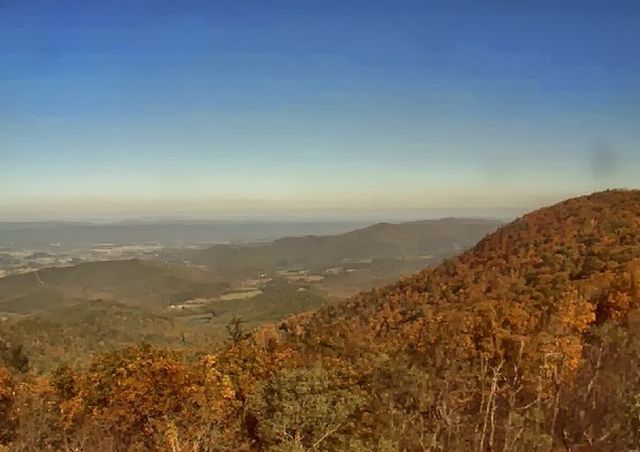Podcast: Play in new window | Download

Spectacular? Not Really. The fall foliage season is increasingly pastel, washed out, as on Virginia’s Blue Ridge Mountains pictured here. The culprit is that visible, constant pall of pollution. (National Park Service Photo)
A long-time friend of, and commenter on, The Daily Impact, Gail Zawacki, has for years maintained a lonely vigil on behalf of trees. On her blog. Wit’s End, she chronicles the massive, mortal harm being done to trees all over the world by air pollution. They are, in fact, slowly dying, a fact that should be most strikingly obvious to everyone in the fall, when by the tens of thousands we drive our emissions-rich cars long distances to see the fall colors. Which, increasingly, aren’t there any more. In part because of the emissions from our cars. Yet no one (except Gail) seems able to see the sick trees for the pale forest.
Here’s a sampling of explanations offered by writers, broadcasters and bloggers throughout the Northeastern United States this year for the pathetic showing of the fall leaves:
- “The deep reds didn’t appear this year, I think it was the lack of a killer frost.” — Vermont
- “I was surprised how the the colors of the foliage on the Blue Ridge and in many areas of the [Shenandoah] Valley are fairly dull in color. Maybe it was the abnormally dry period before the deluge.” — Virginia
- “A hard frost early in the season tends to turn the leaves brown,” says an AccuWeather meteorologist. “On the other hand, [you don’t want it to be] too warm; you want a bit of frost that tends to bring out the brighter colors.”
- “The other factor besides dry was the cicadas which chomped branches and nutrients back in June.” — Virginia
- “It does seem that maybe our extended dry stretch was a bit too much then mix that with the rainy stretch and you’ve got some issues.” — Virginia
- “The best fall color for an area occurs during the shortening days of autumn when days are bright, sunny and cool, when nights are cool but not below freezing, and when there has been ideal rainfall.” — Maryland
So, to sum up then, the problem of the washed-out colors is caused by frost, or lack of frost; rain, or lack of rain, or too much rain, or too little rain for too long followed by too much; or cicadas.
The problem and its cause matter. Set aside for the moment the enormous wound to the living web of life that sustains us all that this represents. It should matter even to industrialists; the U.S. Forest Service estimates that fiery foliage generates $8 billion in tourism revenue annually for New England alone. Foliage season is so important to Vermont that the state employs a leaf forecaster. States throughout the eastern United States avidly harvest tourist dollars every fall foliage season. So they should want to know why the colors are washing out.
Gail Zawacki is trying to tell them:
“The trees are dying from air pollution. It’s a global issue. Trees absorb ozone through their leaves when they photosynthesize and it damages the stomates, because ozone is a highly reactive gas and especially toxic to vegetation. You can’t see ozone, but the background level is inexorably increasing in the lower atmosphere, as more and more precursors are emitted and travel around the world. When plants are injured from repeated, cumulative exposure they lose natural immunity to insects, disease and fungus. It’s a huge problem well known to scientists and agronomists, but they don’t like to publicize it because the only way to deal with it is to drastically curtail fuel emissions and agricultural chemicals.”
Industry is like Aesop’s scorpion, who stings to death the frog carrying him across a stream, thus ensuring his own death, because, he explains with his last breath, “It’s my nature.”







No comments:
Post a Comment